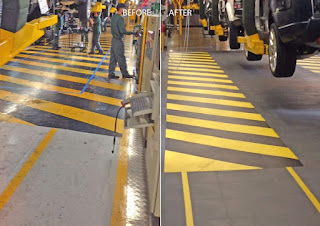T-JOINT INTERLOCK AND ITS IMPACT ON INDUSTRIAL FLOORING PERFORMANCE
Industrial flooring is the backbone of any manufacturing or commercial facility. It serves as the foundation on which heavy machinery, equipment, and goods are handled and transported daily. Ensuring the durability and longevity of industrial flooring is crucial to maintain a safe and efficient working environment. One of the key aspects that significantly affects the performance of industrial flooring is the T-joint interlock system.
The T-joint interlock is a method of connecting concrete slabs in industrial flooring. It involves the formation of T-shaped joints that offer improved load transfer capabilities, reducing the risk of joint failure and enhancing the overall performance of the floor. In this article, we will explore the importance of T-joint interlock and how it influences the performance of industrial flooring.
Importance of Industrial Flooring Performance
Industrial flooring is subjected to a multitude of stresses and challenges on a daily basis. Heavy loads, constant traffic, dynamic loads from moving machinery, temperature fluctuations, chemical exposure, and impact loads are just some of the factors that contribute to the wear and tear of the floor. A poorly designed or constructed floor can result in cracks, surface spalling, and joint failures, leading to safety hazards and costly repairs.
For industrial facilities seeking longevity and cost-effectiveness, investing in a robust flooring system is crucial. The T-joint interlock technique plays a pivotal role in achieving these objectives by enhancing the performance and durability of the industrial floor.
Understanding T-Joint Interlock
T-joint interlock is a type of joint configuration used in industrial flooring, particularly in large, high-traffic areas. It is designed to optimize the load distribution and minimize differential movement between adjacent slabs. The key components of the T-joint interlock include:
Tongue and Groove: The T-joint interlock relies on a tongue and groove design, where one concrete slab features a tongue-like protrusion, and the adjacent slab has a corresponding groove. When the tongue and groove are interlocked, it creates a robust connection, resisting vertical and horizontal movement.
Load Transfer Efficiency: The T-joint interlock enhances the load transfer efficiency between concrete slabs. As heavy loads are applied to the floor, the interlocked joints distribute the weight more evenly, reducing stress concentration at the joints and preventing premature wear and failure.
Crack Control: Concrete slabs tend to develop shrinkage cracks over time due to environmental factors and drying. The T-joint interlock system helps control these cracks, preventing them from spreading across the floor and reducing the need for frequent repairs.
Load Spreading: The T-joint interlock system spreads the load over a larger area, minimizing the pressure on the individual slabs. This feature is particularly beneficial when heavy equipment or forklifts are operated on the floor, as it decreases the likelihood of surface damage.
Performance Benefits of T-Joint Interlock
Increased Durability: The T-joint interlock enhances the overall durability of industrial flooring by reducing stress concentration and improving load distribution. This results in a longer service life and decreased maintenance costs over time.
Improved Safety: Joint failures and surface imperfections can create tripping hazards, endangering the safety of employees and visitors. The interlocked T-joint system reduces the risk of such accidents, promoting a safer working environment.
Enhanced Load-Bearing Capacity: The load-bearing capacity of an industrial floor is crucial to handle heavy machinery and equipment. The T-joint interlock significantly improves this capacity, allowing the floor to withstand higher loads without structural damage.
Minimized Maintenance: T-joint interlock systems require less maintenance than traditional joint configurations. With fewer cracks and joint failures, the need for repairs and refurbishment is reduced, leading to cost savings for the facility.
Improved Aesthetics: Industrial floors with T-joint interlock systems often have a smoother and more uniform appearance due to the controlled crack formation. This adds to the overall aesthetics of the facility and contributes to a more professional and organized atmosphere.
Conclusion
Industrial flooring performance is a critical aspect that can significantly impact the efficiency, safety, and cost-effectiveness of any manufacturing or commercial facility. The T-joint interlock system offers a range of advantages that make it an ideal choice for industrial flooring applications. By improving load distribution, crack control, and load-bearing capacity, the T-joint interlock enhances the overall durability and longevity of the floor.
Facilities that invest in high-quality industrial flooring systems with T-joint interlock technology can expect reduced maintenance costs, improved safety, and a more aesthetically pleasing environment. As the demand for robust and reliable industrial flooring continues to grow, the T-joint interlock system stands out as a key solution to meet these requirements and ensure the seamless functioning of industrial operations.
.jpg)



Comments
Post a Comment